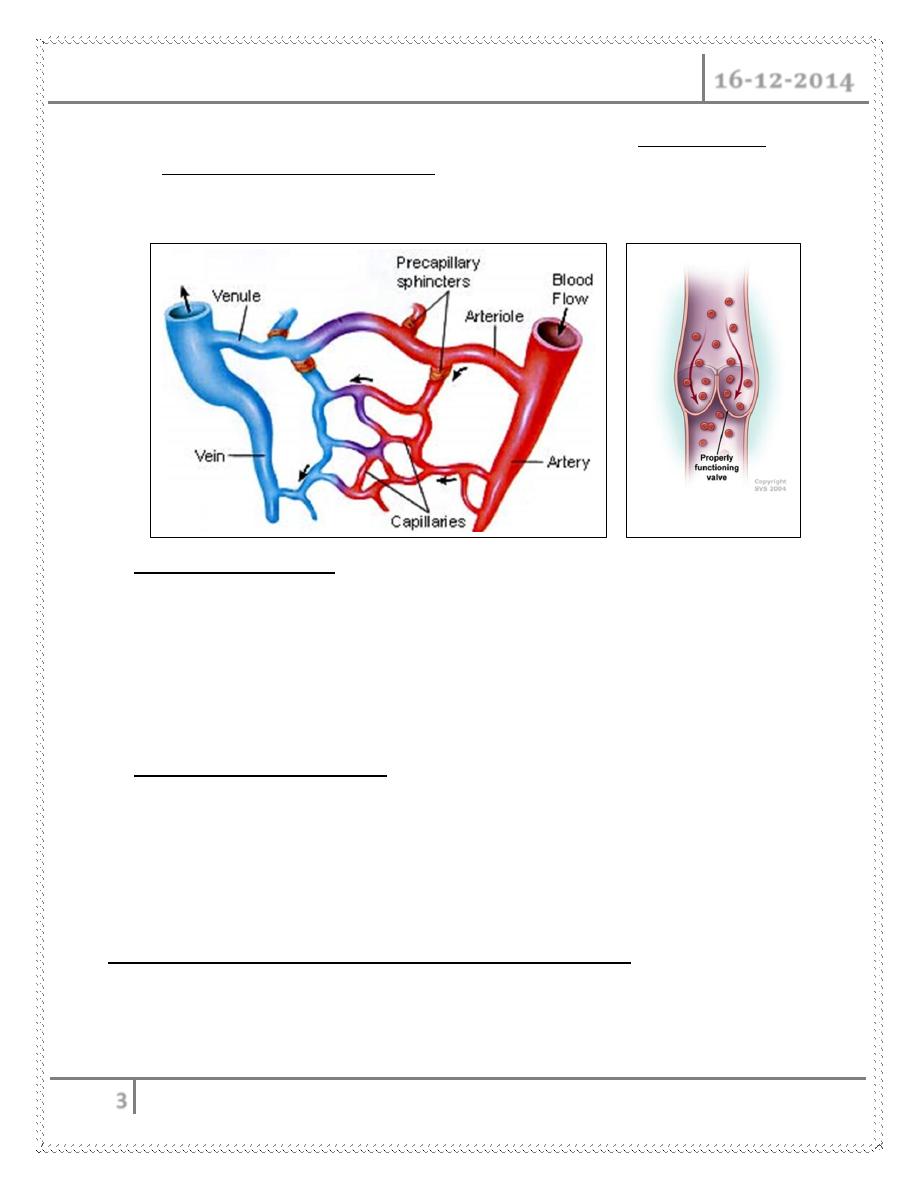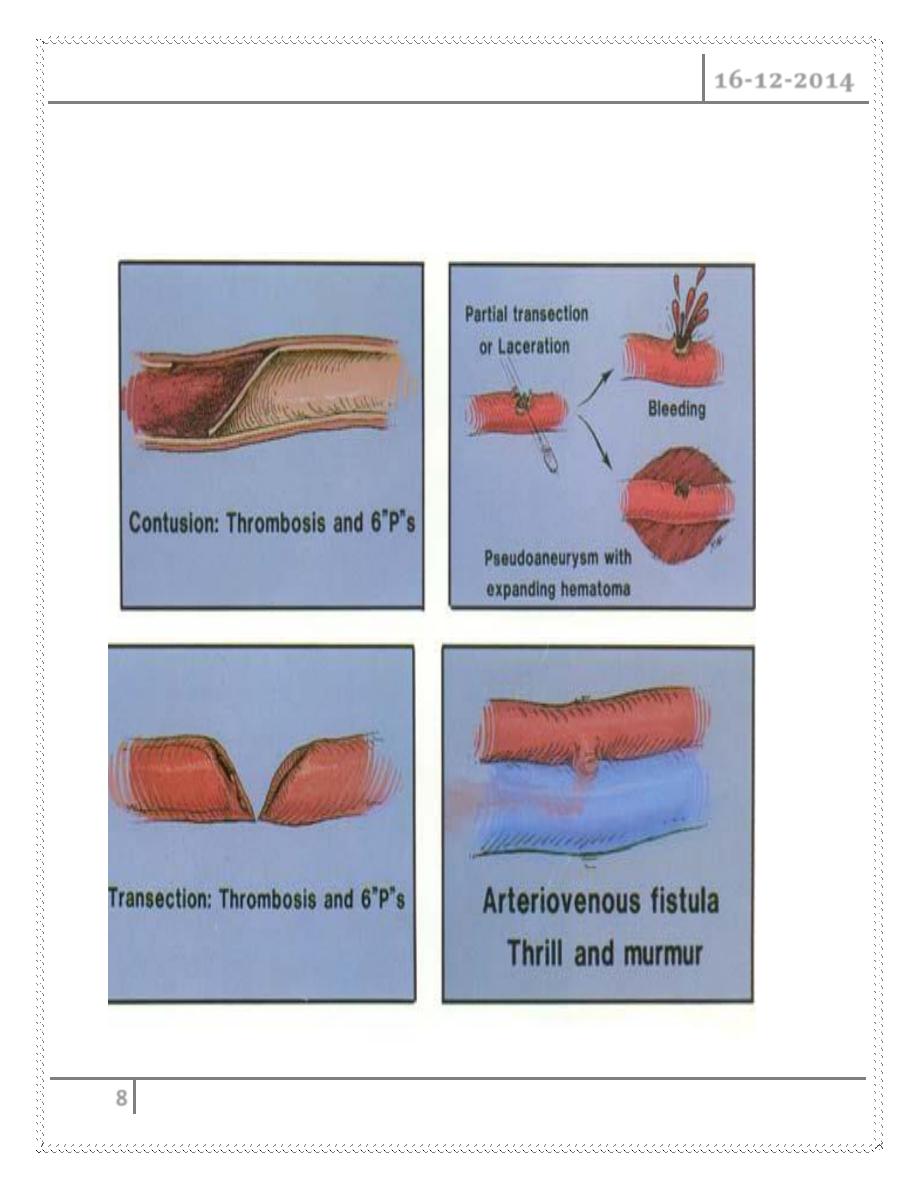
Dr. Abdul Ameer M.
Hussein
Lec. 3
Peripheral Vascular
Diseases
Tues. 16 / 12 / 2014
Published by : Ali Kareem
مكتب اشور لالستنساخ
2014 – 2015

Peripheral Vascular Diseases Dr. Abdul Ameer M. Hussein
16-12-2014
2
Peripheral Vascular Diseases
Objectives :
1- Describe the anatomy of the vessels
2- To differentiate between pathophysiology of acute and chronic ischemia
3- We should know the urgency of acute ischemia
4- To be familiar with methods of investigation in ischemia
5- To understand the principles of management of acute ischemia
Arteries
Are thick-walled vessels that transport 0
2
and blood via the aorta from the
heart to the tissues
3 Layers of Arteries
1- Inner layer of endothelium (intima)
2- Middle layer of connective tissue, smooth muscle and elastic fibers (media)
3- Outer layer of connective tissue (adventitia)
Have smooth muscles that contracts & relaxes to respond changes in blood
volume
Veins
are thin-walled vessels that transport deoxygenated blood from the
capillaries back to the right side of the heart
3 Layers – intima, media, adventitia
there is little smooth muscle & connective tissue
makes the veins more
distensible
they accumulate large volumes of blood

Peripheral Vascular Diseases Dr. Abdul Ameer M. Hussein
16-12-2014
3
Major veins, particularly in the lower extremities, have one-way valves ---
allow blood flow against gravity
Valves allow blood to be pumped back to the heart but prevent it from
draining back into the periphery
Q/ What is an end arteries
An end artery is an artery that is the only supply of oxygenated blood to a
portion of tissue. End arteries are also known as terminal arteries.
Collateral Circulation
Q/ What is collateral circulation ?
This is a process in which small (normally closed) arteries open up and
connect two larger arteries or different parts of the same artery. They can
serve as alternate routes of blood supply.
Investigation of peripheral vascular diseases
General : peripheral vascular disease (atherosclerosis) is a systemic disease
so full investigation is required and this include :

Peripheral Vascular Diseases Dr. Abdul Ameer M. Hussein
16-12-2014
4
o blood picture.
o Biochemical investigation.
o Lipid profile.
o ECG.
o Echocardiography.
Radiological :
o Chest X-ray.
o Abdominal X-ray (aortic calcification).
o CTA scan.
o MRI and MRA. (Magnetic resonance angiography).
Doppler study : ultrasound blood flow detection.
The principle of this examination is by applying a continuous wave
ultrasound signal which is beamed at an artery and reflected beam
picked up by a receiver, presented as a sound waves.
Colored Doppler (duplex scan) which display a real time image of the
vessel structure.
Plethysmography : is an instrument for measuring changes in volume within
an organ or whole body (usually resulting from fluctuations in the amount of
blood or air it contains).
Angiography (Arteriography).
ISCHAEMIA
Means diminish blood supply. It may be acute or chronic according to the speed of
arterial occlusion.

Peripheral Vascular Diseases Dr. Abdul Ameer M. Hussein
16-12-2014
5
The effect of ischemia depends upon :
1- The type of artery
2- The rate of occlusion of the artery
3- The state of the collateral vessels
4- The general condition of the patient, the presence of MI and anemia will
exacerbate the effect of ischemia
Acute Vascular Disease (Ischaemia)
Etiologoy :
Embolism
o Thrombosis
o Trauma.
o Dissecting aneurysm
o Raynaud's Syndrome
Thrombosis
Trauma.
Dissecting aneurysm
Raynaud's Syndrome
Clinical features of limb ischaemia
Clinical diagnosis depends on the 5'p' s
Pain
Paraesthesia
Pallor
Pulselessness
Paralysis
Fixed staining is a late sign
Objective sensory loss requires urgent treatment
Need to differentiate embolism from thrombosis

Peripheral Vascular Diseases Dr. Abdul Ameer M. Hussein
16-12-2014
6
Important clinical features include
Rapidity of onset of symptoms
Features of pre-existing chronic arterial disease
Potential source of embolus
State of pedal pulses in contralateral leg
Management of acute ischaemia
Initial
Heparin & analgesia
Correction of fluid and electrolyte disturbance.
Vasodilators.
Treat associated cardiac disease
Treatment options are:
Embolic disease - embolectomy
Thrombotic disease - intra-arterial thrombolysis / angioplasty or bypass
surgery
Emergency embolectomy
Can be performed under either general or local anaesthesia
Display and control arteries with slings
Transverse artereotomy performed over common femoral artery
Fogarty balloon embolectomy catheters used to retrieve thrombus
If embolectomy fails - on-table angiogram and consider
Bypass graft or intraoperative thrombolysis

Peripheral Vascular Diseases Dr. Abdul Ameer M. Hussein
16-12-2014
7
Management of Peripheral Vascular Trauma
CAUSES OF Vascular Trauma
Penetrating wounds
o Gunshot, stab, or shotgun
o IV drug abuse
Blunt trauma
o Joint displacement
o Bone fracture }Adjacent to major artery
o Contusion
Invasive procedures
o Arteriography
o Cardiac catheterization
o Balloon angioplasty
HARD SIGNS OF ARTERIAL INJURY
(Immediate surgery)
External arterial bleeding.
Rapidly expanding hematoma.
Palpable thrill, audible bruit.
Obvious arterial occlusion
SOFT SIGNS OF ARTERIAL INJURY
(Consider arteriogram, serial examination, duplex)
History of arterial bleeding at the scene
Proximity of penetrating or blunt trauma to major artery
Diminished unilateral distal pulse
Small non pulsatile hematoma
Neurologic deficit

Peripheral Vascular Diseases Dr. Abdul Ameer M. Hussein
16-12-2014
8
Abnormal ankle-brachial pressure index (<0.9)
TYPES OF INJURIES

Peripheral Vascular Diseases Dr. Abdul Ameer M. Hussein
16-12-2014
9
MANAGEMENT
REASONS FOR DIAGNOSTIC STUDIES
Prevent unnecessary operation
Document presence of surgical lesion
Localize surgical lesion to plan operative approach
• DUPLEX SCAN
• CT ANGIOGRAPH
• ARTERIOGRAPHY
Clinical examination and reexamination remain the mainstays for identifying
and treating these trauma
TREATMENT
The priorities of vascular injury are arrest of hemorrhage and restoration of
normal circulation
Airway control and respiratory assessment take priority over management
of the circulation
Volume resuscitation before & after } hemorrhage control

Peripheral Vascular Diseases Dr. Abdul Ameer M. Hussein
16-12-2014
10
Operative Strategy
OPTIONS FOR PERIPHERAL VASCULAR REPAIR
Lateral arteriorrhaphy or venorrhaphy
Patch angioplasty
Resection with end-to-end anastomosis
Resection with interposition graft
Bypass graft
Extraanatomic bypass
Ligation
SPECIAL CONSIDERATIONS FOR VENOUS REPAIR
Popliteal vein is repaired rather than ligated
Ligation of femoral or iliac vein, if necessary, is usually tolerated if elastic
wraps are applied to extremity, which is elevated for 7–10 days
Complex venous repairs functions temporary conduits in many patients but
often show narrowing or occlusion on later venograms

Peripheral Vascular Diseases Dr. Abdul Ameer M. Hussein
16-12-2014
11
Complications
These are considerable and may occur in up to 30% of cases
The major complications are
Thrombosis
Infection
Bleeding
Stenosis
Completion angiography, the use of only autologous material for repair and
adequate soft tissue coverage are the means to decrease these risks
POSTOPERATIVE CARE
Monitor distal arterial pulses by portable doppler unit
Intravenous antibiotics
Antiplatelet agent
Done by
Ali Kareem
